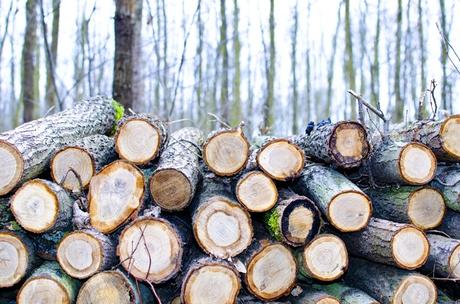Illegal logging is the cutting down of trees, transporting them, or using their products such as timber for economic gains against the prohibition by law. It involves the use of corrupt ways to reach the forests or protected areas, the harvesting or cutting down of the trees without approval, and selling them elsewhere or in black markets as timber.
The excessive extraction of timber beyond the stipulated limits is equally pronounced as illegal logging. As global demand for comedies such as paper, wood and palm oil soars, companies and people continue to encroach even deeper into forests, aggravating the illegal logging problem. In this article, we focus on the underlying causes of illegal logging, its effects and solutions to the pervasive problem.

Causes of Illegal Logging
1. Rural Poverty
In the forest regions, there is always a rural community or indigenous people living within the locality. These communities or tribes are in most cases very poor and entirely depend on the forest for their needs and survival. From food, shelter to fuel, it’s all obtained from the forest. Consequently, they are put in a situation where they source firewood for cooking and heating from the forest that encourages the practice of constant illegal logging.
Most of their shelter construction materials are also sourced from the forest which has led to repeated illegal cutting down of trees to obtain timber. Further, since such villages experience harsh economic situations and considering that the forest is their only source of income, they often collude with illegal loggers for monetary gains. Some may also illegally obtain wood from the forest and sell them to lumber mills.
2. Cheaper products in black markets
The economics of the markets globally equally plays a role in promoting illegal logging. The reason for this is that illegal timber is normally cheaper compared to legal timber in black markets thereby denying legal operators competitive advantage.
To a great extent, this is fueling the demand for illegal timber which means more illegal logging. Importers of illegal logs and the dependency of black wood in countries such as Japan, China, the US, and EU makes the problem even worse.
3. Illegal charcoal, furniture and timber trade
There is an increasing dependency on charcoal, furniture and timber across the world. Charcoal is used for heating and cooking in most developing countries and those who engage in the trade illegally cut down trees which are then used to make the charcoal. High density wood is often preferred to make high quality charcoal, which means the illegal cutting down of hard wood trees.
The soaring demand for furniture and timber also propels the practice of illegal logging, a multi-billion dollar industry involving some of the top government officials and corporate executives as well as big businesses owners who are out for selfish monetary gains.
4. Weaknesses and laxity in forest governance
Forest governance in producer countries very poor and the laws in place are lax at addressing illegal logging concerns. Limited resources, weak institutions, and lax laws have contributed to inadequate law enforcement and the lack of proper land use management. Furthermore, many countries have unclear and poor legal frameworks.
Some are even contradictory. These issues combined leave so many gaps in forest management and governance and as such, it makes it hard for the formal systems to strictly enforce laws guarding against illegal logging. It creates room for businesses and individuals to deliberately over-harvest or take advantage of the legislation gaps.
Effects of Illegal Logging
1. Poor living standards for indigenous populations
The lives of indigenous communities and villagers living in proximity to the forests are usually destroyed in countless ways because of illegal logging. Illegal logging takes away their traditional way of life and livelihoods. Particularly, their tribal cultures are lost if the forest goes away and it also makes it difficult for them to forage which threatens their survival.
Some also depend on the forest resources for income and as such, illegal logging withdraws their only source of income which makes them modern day slaves and shadows of their real cultures.
2. Global warming and climate change
Illegal logging destroys trees that act as carbon sinks and climate regulators which play a significant role in global warming and climate change. Aside from increasing the global temperatures, the practice also accounts for the reduction of the total forest cover area exposing most of the lands to high temperatures and extreme weather conditions.
The illegal clearing of forests to obtain timber is equally responsible for about 11% of carbon emissions which continue to impact climates worldwide. Examples of extreme weather impacts include the wildfires in Portugal, heat waves in phoenix and extreme flooding in Miami beaches.
3. Loss of biodiversity
Forest loss as a result of illegal logging is a threat to biodiversity in forest habitats. More and more species are unable to survive as the practice denies the habitat the crucial natural interconnectedness. The extensive fragmentation and degradation of the forest has put more animal and plant species at the verge of extinction.
It is approximated that the modern day rate of extinction is in the range of 1 to 10 species annually. Research indicates that this rate is only comparable to the historical biodiversity loss caused by catastrophic events such as huge volcanic eruptions.
4. Economic losses
Apart from the numerous environmental consequences of illegal logging, it can also weaken the economy of poor countries. Illegal logging is said to lower the prices of world timber in the ranges of 7% to 16% annually, causing a global revenue loss of about 15 billion US dollars per year.
In poor countries, governments lose revenue from duties and taxes and other costs related to the management of illegal logging. Besides, the losses are not only in terms of current revenue but may also lead to major economic ramifications in the future due to the degradation of valuable natural resources.
5. All countries will feel the combined problems in the long-term
As much as big businesses, top government officials, and executives in corporate world may take the matter of illegal logging less seriously for their own selfish gains and wealth accumulation, it is something that will ultimately affect the whole world.
While other people and countries may think that it only affects the producing countries, the long-term climatic, economic and environmental problems will affect most of the countries in the world. For instance, the illegal logging in Amazon forest is projected to lessen rain in northern China and Midwest US while increasing rain in Northern Europe and Eastern Africa.

Solutions of Illegal Logging
1. Encouragement of forest stewardship
Among the best solutions to illegal logging management is the promotion of forest stewardship programs. Stewardship councils and programs can work as effective tools for managing forests by tracking timber harvesting, transportation and sale.
Such programs can also aid in protecting vulnerable forest areas from further degradation as a result of encroachments or conversion into farmlands. For the effectiveness of forest stewardship programs, it is essential that it works directly with the lumber mills and timber industry to monitor and curtail black markets.
2. Stricter regulations on forest management
Stricter legislations in all countries against illegal logging and the prohibition of importing illegal timber can go a long way in solving the problem. The relevant forest management authorities should take action and utilize their constitutional provisions on environmental protection to enact laws and regulations restricting the practice.
Most states in regions such as Australia, Europe, USA and Asia only prohibit illegal timber and timber products which is pronounced as not enough in the fight against illegal logging. Producing countries with the laws but without enough effort to enforce them must also strive to strengthen their action plans on forest law enforcement. Subjecting the lawbreakers to harsh penalties such as sentencing and huge fines can considerably aid in managing the problem.
3. Legal purchases
We as the consumers can equally be part of the solution and we can contribute by ensuring that we only purchase certified timber products. Serious governments, regional organizations, and third party certification initiatives like the Forest Stewardship Council (FSC) and EU are working round the clock to ensure only certified timber reaches the markets.
These initiatives therefore provide the most outstanding global standards for the management of forest and as consumers; it’s now upon us to be mindful when purchasing timber and its products. By doing this, we will be curtailing illegal logging together with its associated multi-billion dollar industry and illegal markets.
4. Volunteer, donate and spread the word
There are numerous forest management groups, organizations and community programs that work tirelessly to fight illegal logging. From time to time however, these groups and organizations experience challenges in terms of support, funding or manpower.
As custodians of our planet’s resources, it’s important for people join the fight against illegal logging by offering donations or by volunteering. It can be as simple as volunteering a few hours per week, making monetary donations or funding campaigns to organizations such as the Forest Stewardship Council, Greenpeace, and the World Wildlife Fund.
Also, spreading the word about the impacts of illegal logging through blogs, social media, political groups, and community programs can help people understand the issues at hand which can eventually help address the matter.

